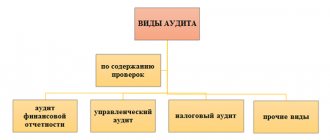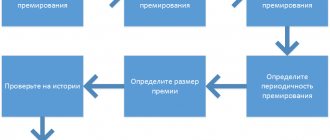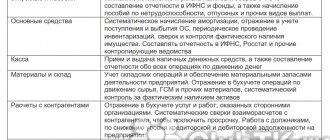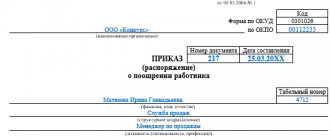What do employees' salaries consist of?
Salary may consist of the following parts:
- a fixed salary that covers basic needs;
- monthly bonuses based on key performance indicators;
- bonuses, the level of which depends on additional incentive systems. For example, an employee may receive bonuses for not giving negative feedback.
Financial incentives are often awarded to employees who effectively allocate resources, have extensive experience working in an online store, bring clients, and take part in promoting affiliate and other programs. The main recipients of bonuses are sales managers , because bonuses make up about 50-60% of their monthly income.
Regular bonuses
Regular bonuses are incentive payments upon achievement of predetermined results. They are permanent and are included in the wage system. If the bonus conditions are met, the employee receives a pre-agreed remuneration. If the conditions are not met, the premium is not paid.
Regular bonuses, in turn, are divided into:
- Monthly.
They are paid every month along with the salary and are included in the average salary of the employee.
- Quarterly.
Paid based on the employee's performance for the quarter. Typically, such bonuses are issued for the 1st, 2nd and 3rd quarters.
- Annual.
The calculation period for calculating this bonus is from January 1 to December 31. It is paid once a year, subject to the fulfillment of a production task.
Data on regular bonuses are not entered into the employee’s work book or personal card.
Why use bonus systems?
The opportunity to increase wages through bonuses attracts specialists who are confident in their abilities and experience. They know how to conclude a lot of deals, they are interested in ensuring that the store does not receive negative reviews, and that customers become regulars. All this has a positive impact on:
- quantity and dynamics of sales;
- staff loyalty to the management of the online store;
- sales features. An employee can sell leftover goods, as well as out-of-season products or those that have been stored in a warehouse for a long time;
- the impressions that customers receive from quality service;
- reducing the percentage of abandoned carts;
- general situation in the team.
Material interest is the best method of stimulating staff activity. It allows you to put all employees on an equal footing; their income will depend only on two factors – quality of work and KPI.
Bonuses vs fines: what to choose?
Along with bonuses, systems of fines are sometimes established based on indicators chosen by the business owner. For example, fines may be assessed if an employee did not fulfill a sales plan, communicated impolitely with a client, or made other mistakes. The feasibility of introducing a fine system determines the number of personnel, working conditions, as well as the chosen business and management styles.
When introducing fines, additional factors need to be taken into account. If an employee did not have time to process orders received during the high sales season, then you need to think not about cutting salaries, but about hiring temporary staff. It is worth remembering that bonuses encourage people to work better, while fines can demoralize the team.
The employee has the right to sue the company for deprivation of bonuses within one year
Since October 2016 Art. 392 of the Labor Code of the Russian Federation is set out in an updated version, according to which the period for an employee to go to court to collect unpaid wages or bonuses has been extended 4 times - from 3 months to 1 year.
It is counted from the day set by the employer for payment of the uncollected amount.
Editor's note:
in the previous 3-month period, many employees dissatisfied with the deprivation of bonuses did not have time to file a claim. This followed from their numerous appeals received by the Ministry of Labor of the Russian Federation and Rostrud, as well as from court decisions refusing to consider the claim due to the expiration of the statute of limitations. The problem was that after a long wait for payment of wages or bonuses, workers first turned to the labor inspectorate, as well as other regulatory government agencies, and only after that to the court, and by this time the 3-month period, as a rule, had already expired.
Now a year should be enough for all authorities.
This period must be calculated from the date when the employee learned or should have learned about the non-payment of the bonus. This is usually the set date for payment. The fact that the employee is deprived of it, he must find out from the pay slip and the deprivation order, as well as when a shortage is detected in the amount that is transferred to his card.
If neither the pay slip nor the order were brought to him, and it is impossible to identify the transferred amount on the card (for example, due to the fact that the purpose of the payment was not indicated), then the starting point can be shifted forward, and quite significantly, up to date of dismissal of the employee (Appeal ruling of the Penza Regional Court dated September 23, 2014 No. 33-2122).
Classification of bonus systems
The systems under consideration are classified according to the frequency of accrual:
- monthly;
- quarterly;
- annual (paid at the end of the current or beginning of the new year, the amount is equivalent to a monthly salary).
There are also the following types of bonuses awarded for certain successes in work:
- exceeding the plan;
- performing complex tasks;
- winning competitions, participating in events and webinars necessary to popularize and improve the reputation of the online store;
- long term of work in the online store;
- special achievements aimed at improving and developing the online store;
- active attraction of new clients.
A separate group should include bonuses that are not directly related to the implementation of business tasks. We are talking about payments dedicated to birthdays, secular and religious holidays, retirement and other, but no less important events.
Contents and forms of bonuses
Employee bonuses
1. Documentation and procedure for payment of bonuses.
A bonus is a monetary payment of an incentive or incentive nature in addition to the employee’s basic earnings.
The award can be:
- provided for by the remuneration system, i.e. regulations on bonuses, labor or collective agreements or other local regulations of the enterprise. Article 144 of the Labor Code of the Russian Federation gives the employer the right to establish various systems of bonuses, incentive payments and allowances, taking into account the opinion of the representative body of employees. These systems can also be established by collective agreement. At the same time, the bonus remuneration system adopted by the organization must provide for the payment of bonuses to a certain circle of people based on pre-established specific indicators and bonus conditions.
- is not provided for by the remuneration system, i.e. one-time bonus. According to Article 191 of the Labor Code of the Russian Federation, an employer can reward employees who conscientiously perform their job duties. Employees may be paid one-time bonuses for increased productivity, for many years of conscientious work, and for other achievements in work.
It should be noted that if a bonus is provided for by the remuneration system, then the employer has an obligation to pay the bonus, and the employee, if he fulfills the indicators and conditions of the bonus, has the right to demand payment of the bonus. Payments of one-time incentive bonuses are made only by decision of the employer, and the employee does not have the right to demand their payment.
Bonuses are paid based on the order of the manager. Resolution of the State Statistics Committee of Russia dated April 6, 2001 N 26 approved the following unified forms:
- Order (instruction) to reward an employee - form N T-11;
- Order (instruction) on incentives for employees - form N T-11a.
The order must indicate:
- last name, first name and patronymic of the awarded employees, their personnel numbers, positions and the structural unit in which they work;
- the reason for paying the bonus (for example, based on the results of the organization’s activities for the year);
- bonus amount;
- the basis for calculating the bonus (for example, a memo from the head of a structural unit).
The order is signed by the head of the organization or a person authorized by him and announced to the employee(s) against signature. Based on the order (instruction), a corresponding entry is made in the employee’s work book.
2. Prize amount
When deciding the amount of the bonus, the following must be taken into account.
According to Article 144 of the Labor Code of the Russian Federation, the employer has the right to establish various bonus systems, incentive payments and allowances, taking into account the opinion of the representative body of employees. These systems can also be established by collective agreement.
The procedure and conditions for the application of incentive and compensation payments (additional payments, allowances, bonuses and others) are established:
- in organizations financed from the federal budget - by the Government of the Russian Federation;
- in organizations financed from the budget of a constituent entity of the Russian Federation - by government bodies of the corresponding constituent entity of the Russian Federation;
- in organizations financed from the local budget - by local governments.
Thus, all other organizations have the right to independently establish various bonus systems. In this case, the size of the bonus is limited only by the relevant internal documents of the enterprise (Regulations on bonuses, collective agreement, etc.).
3. Accounting for bonuses
The amount of the accrued premium may:
- included in expenses for ordinary activities;
- be included in non-operating expenses;
- paid from the organization's retained earnings.
According to paragraphs 5 and 7 of the Accounting Regulations “Expenses of the Organization” (PBU 10/99), approved by Order of the Ministry of Finance of the Russian Federation dated May 6, 1999 No. 33n, the organization’s expenses for remuneration of the organization’s employees form expenses for ordinary activities. Thus, if the payment of a bonus is related to the production process, then the accrued bonus will be included in expenses for ordinary activities. If the payment of a bonus is not related to the production process (for example, payment of bonuses for an anniversary or other holiday), then the accrued bonus will be included in non-operating expenses.
When paying bonuses from retained earnings, it is necessary to take into account the provisions of civil law. According to paragraph 3 of paragraph 3 of Article 91 of the Civil Code of the Russian Federation, issues of distribution of profits of a limited liability company are within the exclusive competence of the general meeting of participants of the company. A similar rule is provided for joint stock companies, clause 4, clause 1, article 103 of the Civil Code of the Russian Federation. Thus, the use of retained earnings to pay bonuses without the consent of the participants (founders) or shareholders of the organization is not allowed. The decision to spend retained earnings is drawn up on the basis of the minutes of the general meeting of participants (founders) or shareholders of the organization.
In accordance with the Chart of Accounts, accounting for settlements with employees of the organization for all types of remuneration, including bonuses, is carried out on account 70 “Settlements with personnel for remuneration”. The following subaccounts can be opened for this account: 70-1 “Settlements with employees on staff of the organization”; 70-2 “Settlements with part-time workers”; 70-3 “Settlements under civil contracts.”
In accounting, the accrual of bonuses is reflected in the following order:
Debit 08 Credit 70 - bonus accrued for construction work; Debit 20 Credit 70 - a bonus was accrued to employees of the main production; Debit 23 Credit 70 - bonus accrued to employees of auxiliary production; Debit 25 Credit 70 - bonus accrued to general production personnel; Debit 26 Credit 70 - bonus accrued to administrative and management personnel; Debit 28 Credit 70 - a bonus was accrued for work to correct the defect; Debit 29 Credit 70 - bonus accrued to employees of service industries; Debit 44 Credit 70 - a bonus was awarded to employees involved in the sale (packaging, storage, delivery) of products; Debit 84 Credit 70 - bonus accrued from retained earnings; Debit 86 Credit 70 - premium accrued from target financing funds; Debit 91-2 Credit 70 - a one-time bonus was accrued for the holiday; Debit 70 Credit 50, (51) - bonus was paid to employees from the cash register (transferred from the current account).
Analytical accounting for account 70 “Settlements with personnel for wages” is maintained for each employee of the organization.
4. Taxation of bonuses
Income tax
Let's consider in what cases bonuses are taken into account as part of labor costs, and in what cases they do not reduce the tax base for income tax.
1. Bonuses taken into account as part of labor costs (reducing the tax base for income tax).
According to Article 255 of the Tax Code of the Russian Federation, the taxpayer’s expenses for wages include any accruals to employees in cash and (or) in kind, incentive accruals and allowances, compensation accruals related to working hours or working conditions, bonuses and one-time incentive accruals, expenses associated with the maintenance of these workers, provided for by the norms of the legislation of the Russian Federation, labor agreements (contracts) and (or) collective agreements.
Labor costs include, in particular, incentive accruals, including bonuses for production results, bonuses to tariff rates and salaries for professional excellence, high achievements in work and other similar indicators (Clause 2 of Article 255 of the Tax Code of the Russian Federation) . It is necessary to take into account that, according to Article 252 of the Tax Code of the Russian Federation, in order to determine taxable profit, the taxpayer reduces the income received by the amount of expenses incurred, with the exception of expenses specified in Article 270 of the Tax Code of the Russian Federation.
According to paragraphs 21 and 22 of Article 270 of the Tax Code of the Russian Federation, expenses that do not reduce the tax base for income tax include, in particular:
- expenses for any types of remuneration provided to management or employees in addition to remuneration paid on the basis of employment agreements (contracts);
- expenses in the form of bonuses paid to employees from special-purpose funds or targeted revenues. At the same time, special-purpose funds, in particular, mean funds designated by the owners of organizations for the payment of bonuses.
Let us present the position of the tax authorities on this issue, outlined in paragraph 5.2 of the Methodological Recommendations for Chapter 25 of the Tax Code of the Russian Federation, approved by Order of the Ministry of Taxes of the Russian Federation of December 20, 2002 N BG-3-02/729.
It should be noted that paragraph 21 of Article 270 of the Tax Code of the Russian Federation stipulates that expenses not taken into account for profit tax purposes include expenses for any types of remuneration provided to management or employees, in addition to remuneration paid on the basis of employment agreements (contracts).
Thus, labor costs should be taken into account for profit tax purposes only if the norms of the collective agreement, internal labor regulations of the organization, provisions on bonuses and (or) other local regulations adopted by the organization are reflected in a specific employment contract, concluded between the employer and the employee. The requirements for employment contracts concluded between an employee and an employer are provided for in Section 3 of the Labor Code of the Russian Federation.
At the same time, the employment contract allows (except for the essential terms of the employment contract) references to the norms of the collective agreement, internal labor regulations of the organization, provisions on bonuses and (or) other local regulations without their specific decoding in the employment contract. In this case, it will be considered that these local regulations will apply to a specific employee.
Accordingly, if the employment contract concluded with a specific employee does not include certain accruals provided for in the mentioned collective agreement and (or) local regulations, or there are no references to them, then such accruals cannot be accepted for profit tax purposes.
Thus, from all of the above it follows that in order for the premium to be taken into account as expenses, the following conditions must be met:
- the premium is not paid from special purpose funds or earmarked revenues;
- the bonus is paid for production results;
- the bonus is paid in accordance with the bonus system adopted at the enterprise, fixed in the Regulations on bonuses, a collective agreement or in another local regulatory act of the enterprise. In this case, the employment contract must contain a reference to the relevant local regulatory act of the enterprise.
2. Bonuses that do not reduce the tax base for income tax.
Premiums that do not reduce the tax base for income tax are not subject to UST on the basis of clause 3 of Article 236 of the Tax Code of the Russian Federation. Therefore, in order to optimize taxation, in some cases it is more profitable for an enterprise to pay income tax at a rate of 24% than the unified social tax at a rate of 35.6%.
Taking into account the provisions of paragraph 1 of this section, we present conditions, if at least one of which is met, bonuses do not reduce the tax base for income tax.
- (one hundred percent option) The award is paid from special purpose funds or targeted revenues. Once again, please note that bonuses can be paid from retained earnings only by decision of the general meeting of participants (founders) or shareholders of the organization. The decision to spend retained earnings is drawn up on the basis of the minutes of the general meeting of participants (founders) or shareholders of the organization.
- The bonus is not paid for production results, but is of a social nature. At the same time, indicate in the collective or employment agreement that the bonus is paid regardless of the production results of labor.
- The employment contract should not provide for the payment of bonuses and should not make reference to the relevant local regulatory act of the enterprise.
Personal income tax
Article 217 of the Tax Code of the Russian Federation provides an exhaustive list of income that is not subject to taxation. Since bonuses are not included in the specified list, they are subject to taxation in full in the manner established by Chapter 23 of the Tax Code of the Russian Federation.
UST
According to paragraph 1 of Article 236 of the Tax Code of the Russian Federation, the object of taxation under the Unified Social Tax for organizations is payments and other remuneration accrued by taxpayers in favor of individuals under employment and civil law contracts, the subject of which is the performance of work, the provision of services (with the exception of remunerations paid to individual entrepreneurs) , as well as under copyright agreements. At the same time, these payments and remunerations (regardless of the form in which they are made) are not recognized as an object of taxation, if for taxpayer organizations such payments are not classified as expenses that reduce the tax base for income tax (clause 3 of Article 236 of the Tax Code of the Russian Federation).
Thus, if bonuses do not reduce the tax base for income tax, then such bonuses are not subject to unified social tax on the basis of paragraph 3 of Article 236 of the Tax Code of the Russian Federation. If bonuses are taken into account as part of labor costs that reduce the tax base for income tax, then such bonuses are subject to unified social tax in the generally established manner.
5. Formation of a reserve for the payment of annual remuneration for length of service
Article 324.1 of the Tax Code of the Russian Federation gives the organization the right to create a reserve for future expenses for the payment of annual remunerations for length of service and based on the results of work for the year. It is formed in the same way as the reserve for upcoming vacation pay (clause 6 of Article 324.1 of the Tax Code of the Russian Federation).
Organizations that have decided to take equal account for tax purposes of upcoming expenses for the payment of annual remunerations for length of service and based on the results of work for the year are obliged to:
- reflect in the accounting policy for tax purposes the accepted method of reserving, determine the maximum amount of deductions and the monthly percentage of deductions to the specified reserve;
- draw up a special calculation (estimate), which reflects the calculation of the amount of monthly contributions to the specified reserve, based on information about the estimated annual amount of expenses for vacations, including the amount of the single social tax on these expenses. In this case, the percentage of contributions to the specified reserve is determined as the ratio of the estimated annual amount of expenses for vacation pay to the estimated annual amount of labor costs.
- carry out an inventory of the specified reserve at the end of the tax period. The amounts of the specified reserve that were underused on the last day of the current tax period are subject to mandatory inclusion in the tax base of the current tax period. If the funds of the actually accrued reserve, confirmed by the inventory on the last working day of the tax period, are insufficient, the taxpayer is obliged, as of December 31 of the year in which the reserve was accrued, to include in expenses the amount of actual expenses for paying for vacations and, accordingly, the amount of the unified social tax for which previously the specified reserve was not created.
If, when clarifying the accounting policy for the next tax period, the taxpayer considers it inappropriate to form a reserve for future expenses for the payment of annual remunerations for length of service and based on the results of work for the year, then the amount of the balance of the specified reserve identified as a result of the inventory as of December 31 of the year in which it was accrued, for tax purposes is included in non-operating income of the current tax period.
Example.
The organization's accounting policy for 2003 provided for the creation of a reserve for future expenses for the payment of annual remunerations based on the results of the year.
The estimated annual amount of expenses for this reserve (including unified social tax) amounted to 76,000 rubles. The estimated amount of labor costs (including unified social tax) amounted to 800,000 rubles. Let's determine the monthly percentage of contributions to the reserve: 76,000 rubles. : 800,000 rub. x 100% = 9.5%.Let's consider the formation of the reserve in January 2003. Actual labor costs for January (including unified social tax) amounted to 60,000 rubles. The percentage of contributions to the reserve in January will be:
60,000 rub. x 9.5% = 5,700 rub.
The amount of contributions to the reserve in all subsequent months is calculated in a similar way. According to clause 3.51 of the Methodological Guidelines for the Inventory of Property and Financial Liabilities, approved by Order of the Ministry of Finance of Russia dated June 13, 1995 N 49, if the actually accrued reserve exceeds the amount of the calculation confirmed by the inventory in December of the reporting year, a reversal entry of production and distribution costs is made, and in the event of an underaccrual An additional entry is made to include additional deductions in production and distribution costs. If part of the reserve remains unused. Let's assume that the total accrued amount of the reserve for 2003 was 80,000 rubles. At the same time, the total amount of remunerations accrued in December based on the results of work for the year amounted to 72,000 rubles. (including unified social tax). In accounting, transactions related to the formation of a reserve are reflected by the following entries:
Dt 20 (23, 25, etc.) Kt 96 - 80,000 rub. — contributions to the reserve were accrued during 2003; Dt 96 Kt 70, 69 - 72,000 rub. — remunerations were accrued based on the results of work for the year (including unified social tax) to the employees of the enterprise; Dt 20 (23, 25, etc.) Kt 96 - RUB 8,000 RUR. (80,000 rubles - 72,000 rubles) - the unused amount of the reserve was restored.
For tax purposes, the unused reserve amount is RUB 8,000. included in non-operating income for income tax as of December 31, 2003. If the accrued reserve funds were insufficient. Let's assume that the total accrued amount of the reserve for 2003 was 80,000 rubles. At the same time, the total amount of remunerations accrued in December based on the results of work for the year amounted to 85,000 rubles. (including unified social tax). In accounting, transactions related to the formation of a reserve are reflected by the following entries:
Dt 20 (23, 25, etc.) Kt 96 - 80,000 rub. — contributions to the reserve were accrued during 2003; Dt 96 Kt 70, 69 - 85,000 rub. — remunerations were accrued based on the results of work for the year (including unified social tax) to the employees of the enterprise; Dt 20 (23, 25, etc.) Kt 96 - 5,000 rub. (85,000 rubles - 80,000 rubles) - the underaccrued amount of the reserve is included in the costs.
For tax purposes, the underaccrued reserve amount is RUB 5,000. included in income tax expenses for the payment of annual remuneration (including Unified Social Tax) as of December 31, 2003.
6. Bonuses when calculating average earnings
When calculating average earnings, you must be guided by Article 139 of the Labor Code of the Russian Federation and Decree of the Government of the Russian Federation dated April 11, 2003 N 213 “On the specifics of the procedure for calculating the average salary,” which approved the Regulations on the specifics of the procedure for calculating the average salary (hereinafter referred to as the Regulation). The procedure for including bonuses in the calculation of average earnings is provided for in clause 14 of the Regulations.
When determining average earnings, bonuses and rewards actually accrued for the billing period are taken into account in the following order:
- monthly bonuses and rewards - no more than one payment for the same indicators for each month of the billing period;
- bonuses and remunerations for a period of work exceeding one month - no more than one payment for the same indicators in the amount of the monthly part for each month of the billing period;
- remuneration based on the results of work for the year, a one-time remuneration for length of service (work experience), other remunerations based on the results of work for the year, accrued for the previous calendar year - in the amount of one twelfth for each month of the billing period, regardless of the time the remuneration was accrued.
Example.
The employee of the organization will be granted regular leave from May 5, 2003. Her monthly salary is 5,000 rubles. In addition to the salary, remuneration was paid in January based on the results of work for 2002 - 3,000 rubles. (provided for by the Regulations on bonuses), in March a quarterly bonus was paid for the first quarter (provided for by the Regulations on bonuses) - 1000 rubles. and a one-time bonus for International Women's Day - 500 rubles. (not provided for in the Bonus Regulations). Let us determine the amount of payments taken into account when calculating average earnings:
- salary - 15,000 rubles (5,000 rubles x 3);
- remuneration based on the results of work for 2002 - 750 rubles (3000 rubles: 12 x 3);
- quarterly bonus - 1000 rubles.
The one-time bonus for International Women's Day (500 rubles) is not taken into account, since it is not provided for by the remuneration system. It should be noted that it does not matter for what period the bonuses are accrued and when they are paid. The main thing is that the bonus is accrued during the billing period - then it is taken into account when calculating average earnings (in accordance with the specifics of clause 14 of the Regulations). If the time falling within the billing period is not fully worked or time is excluded from it in accordance with paragraph 4 of the Regulations, then bonuses and remunerations are taken into account when determining average earnings in proportion to the time worked in the billing period (with the exception of monthly bonuses paid along with wages for a given month). If an employee has not worked for the organization for a full working period for which bonuses and rewards are accrued, and they were accrued in proportion to the time worked, then they should be taken into account when determining average earnings based on the amounts actually accrued in the manner established by this paragraph of the Regulations.
Example.
The employee of the organization will be granted regular leave from May 5, 2003. According to the wage system, his salary is 5,000 rubles. and monthly bonus - 3000 rubles. In February, the employee was sick for 4 days, so his salary was 6,320 rubles. (salary 3950 rubles and bonus 2370 rubles). Let's determine the amount of payments taken into account when calculating average earnings: 5000 + 5000 + 3950 + 3000 + 3000 + 2370 = 22,320 rubles. The bonus amount for February taken into account when determining average earnings is 2,370 rubles, therefore, there is no need to determine the proportion again.
In conclusion, I would like to note that the system of material incentives for employees is a powerful incentive and always has a beneficial effect on productivity and labor efficiency. Therefore, we recommend that employers take advantage of the right granted by Article 144 of the Labor Code of the Russian Federation and develop a system of bonuses for employees in their organization. The consequences are obvious:
- Your organization will ensure that it attracts and retains highly qualified staff;
- Each employee will develop the desire to achieve the best results in their workplace and, as a result, achieve the goals facing the organization as a whole.
| New generation berator PRACTICAL ENCYCLOPEDIA OF AN ACCOUNTANT What every accountant needs. The full scope of always up-to-date accounting and taxation rules. Connect berator |
What should you pay attention to when choosing a priority reward system for an online store?
Most often, online store owners hire managers who are willing to receive a small salary and a significant percentage of sales. The scheme is simple and understandable; it encourages staff to work more actively , because without sales there will be no bonuses. However, it has a number of strong disadvantages:
- does not unite, divides the team. Competitive managers deviate from group work standards;
- employees will focus on old customers who are guaranteed to make a purchase. Therefore, attracting new customers will be not only slow, but also reluctant;
- during the season of low sales, the manager will receive mainly a “bare” salary.
Other disadvantages may appear in the process of calculating bonuses at different times of the year. Therefore, the classic bonus system should be improved with:
- changes in the base rate taking into account seasonality and the level of demand;
- division of the bonus accrual system taking into account the type of clients (new, old, regular, non-regular);
- regularly performing collective or quick tasks.
When developing a bonus system, you need to take into account not only sales managers, but also warehouse employees, accountants, online consultants and others. It is difficult to determine production in this case, so it is advisable to use fixed bonuses . If a storekeeper or accountant completes his work without errors within a month, he receives a solid bonus along with his salary. This system encourages staff to take their work more responsibly.
Individual plans and threshold bonus system
The classic system can be linked to threshold payments by setting up an individual plan for each employee (mostly sales managers). If a minimum indicator of 70% of the plan is set, but the manager does not fulfill it, then bonuses will not be awarded. If the plan is fulfilled, the bonus will be 0.5% of the transaction amount or 1/3 of the fixed salary. If the plan is exceeded, the bonus can reach 2% of sales or be equivalent to one salary. The system has several thresholds, for each of which an individual reward coefficient is set:
- minimum;
- average;
- high;
- overfulfillment.
The entrepreneur regulates the minimum and maximum thresholds, as well as the percentage of sales, independently , based on important indicators:
- monthly sales volumes;
- seasonality;
- niche;
- staff turnover;
- number of staff;
- average bill or transaction amount, others.
The system is flexible; plans can be changed during the year, which will help maintain payments at a high level and prevent staff turnover. The main feature is the transparent formation of bonus rates and equal conditions for all employees. Both old and new managers who successfully implement the plan receive bonuses. Another plus is the ability to monitor work efficiency, as well as make decisions on personnel changes, taking into account the productivity of each individual person.
An unpaid bonus can expose a low salary and force you to pay extra to the minimum wage
The employee demanded in court to recover back wages from the employer in the form of unpaid bonuses, as well as underpaid wages.
Regarding the bonus, the court rejected the claim because it saw no basis for its payment: from the terms of the employment contract it followed that bonus payments are of an incentive nature and are not a guaranteed part of the salary; payment of the bonus is the exclusive right of the employer, but not his responsibility.
The court was not presented with evidence that the company made decisions to pay the plaintiff a bonus during the disputed period, as well as evidence of a positive result in the performance of his labor functions.
As for the salary, the court ordered the company to pay the employee a certain amount.
The fact is that he received from 14 to 23 thousand rubles monthly. At the same time, from the terms of the employment contract, pay slips, as well as 2-NDFL certificates, it followed that in the indicated amounts the official salary was only 12 thousand rubles, the rest were bonuses.
Meanwhile, in the city of Moscow, the minimum wage from 06/01/2015 was set at 16.5 thousand rubles, from 11/01/2015 - 17.3 thousand rubles, from 10/01/2016 - 17.5 thousand rubles.
By virtue of Art. 133.1 of the Labor Code of the Russian Federation, salaries in the capital cannot be lower than these amounts.
In this regard, the employee must be paid an additional 72 thousand rubles,” the judges concluded.
APPEAL DECISION of the Moscow City Court dated September 18, 2017 No. 33-32389/2017
Which rewards program should you choose?
In an online store, you can use either one or several programs, depending on the tasks. Often a combined classical and threshold system is used, supplemented by flexible payments. In the latter case, employees receive fixed bonuses for completing tasks of varying complexity. For example, a manager who closed 4 transactions during the day receives 1000 hryvnia. Flexible payments are the best solution if an online store needs to quickly achieve any goals. For example, to overtake competitors or quickly sell off leftovers as part of preparing the warehouse for a new batch of goods.
When developing and implementing such programs, it is impossible to equate all employees, so it is worth using the classification:
- personnel whose output cannot be determined (accountant, driver, warehouse employees, others);
- level of managers: beginners, experienced specialists;
- management team.
Fixed bonus rates are used for personnel whose activities do not have a direct impact on business development. Flexible programs tied to plans or seasons are effective for managers.
What types of bonuses are there for employees - the main classifications of types of bonuses and their differences
The current legislation does not establish types of bonuses. In Art. 191 of the Labor Code of the Russian Federation states that bonuses are incentive payments for conscientious performance of duties. In practice, organizations pay various types of bonuses, which can be classified:
By the number of employees awarded:
- Individual awards. Paid to a specific employee.
- Collective awards. Paid to a group of employees. They can work in the same department or division. As a rule, bonuses are paid when joint results are achieved in work activities, for example, the fulfillment of certain indicators.
In order to determine the amount of payments:
- In a fixed amount of money.
- As a percentage of salary.
- In shares of salary.
- As a percentage or fraction of the total salary (for example, from salary + bonus for length of service, etc.).
According to the frequency of accrual.
- One-time.
- Systematic. They can be paid once a month, once a quarter, semi-annually or annually.
Based on the basis for calculation.
- For good work.
- For fulfilling the plan.
- For any other employee achievements.
According to the method of consolidation in the organization:
- Enshrined in employment contracts.
- Collective agreements.
- Local acts.
- Agreements.
- Not fixed in internal documents, paid at the initiative of the manager (these bonuses are not provided for in the remuneration system).
Next, let's talk about the main types of employee bonuses that are most often found in organizations.
Stages of developing a bonus system
Development is carried out in stages, it is necessary to determine:
- program goals: increasing sales, motivating staff, others;
- program participants, and then divide them into groups;
- key indicators by which performance will be assessed;
- the type of bonuses, as well as the scheme for accruing them.
After this, you need to formulate individual plans if a threshold system is used. It is recommended to conduct an analysis 2-3 months after the start of the program to obtain data on achievements and errors.
Development of a bonus system
Conditions for payment of bonuses
The indicators at which an employee is paid a bonus are:
- High quality.
They are determined not by the number of actions performed, but by their result (quality). These indicators include: a high level of customer service, the absence of comments and errors in work, the introduction of new innovative ideas into production. Qualitative bonus indicators are suitable for assessing the work of employees not involved in the production process.
- Quantitative.
Such indicators have a clear numerical expression. These include: concluding a certain number of transactions, fulfilling a plan for the production of goods, selling a large number of goods. Quantitative assessment of labor is more suitable for workers involved in the production process.
Bonus conditions are prescribed in the Regulations on Bonuses, an employment contract or other local regulatory act (LNA). You can learn how to draw up a Regulation on bonuses for employees from this article.
If the bonus is not included in the remuneration system (one-time bonus), the conditions for its payment do not need to be specified separately. More information about the reasons for rewarding employees can be found here.
Analysis of the effectiveness of the selected program
Having implemented the program, it is worth assessing its effectiveness using the following tools:
- Conducting surveys among staff to help obtain an opinion on whether employees are satisfied with the level of remuneration. If you need a transparent result, then you should focus on anonymous surveys;
- tracking indicators related to sales and the level of bonuses that each employee receives (production, number of closed transactions, average transaction amount, type of customers, others);
- assessment of the atmosphere in the team. Programs that cause unhealthy competition need to be corrected.
Employee bonus systems need to be periodically reviewed, because the market changes, and with it the requirements for wage levels. The need to adjust such a system may arise as a result of:
- expansion, reduction or complete change of assortment;
- increase or decrease in staff;
- expansion of the client base;
- changes in working conditions, for example, the transition to a remote work format.
The programs under consideration allow us to determine the labor efficiency of each employee. They increase engagement, encourage staff to work harder and better, and also contribute to the formation of a healthy corporate microclimate.
How bonuses differ from bonuses, incentive payments and rewards
In each organization, the types of bonuses and incentive payments are fixed at the local level. Internal administrative documents describe the list of incentives and the procedure for their payment. Bonuses and incentives are similar in essence, but they are not the same thing.
Incentive payments are any additional payments, allowances and incentives that increase wages to motivate an employee to work. That is, bonus payments are included in the concept of incentives. Bonuses are a narrower concept than incentives.
But the difference between a bonus and a bonus is not so significant. Bonus is a periodic or one-time payment related to labor achievements and non-labor events. A bonus is a one-time reward paid to motivate an employee, or an incentive gift. Thus, the concept of a bonus refers to a one-time bonus.
When promotion is deprived
According to the rules, when paying a bonus based on the results of work for the quarter, the objects of the bonus are the employees of the organization. Employees are encouraged in accordance with the bonus regulations and other internal regulations. The employer provides not only the procedure for incentives, but also cases in which the employee is deprived of additional incentives.
The same provision prescribes the frequency of payments and the procedure for calculating the salary bonus for 3 months of work (once a quarter). That is, the maximum number of such periodic payments per year is 4. To receive a quarterly payment, the employee must comply with the established work schedule, work efficiently and fulfill the production plan (if there is one). Here's what they're depriving of financial incentives for:
- for violations of labor discipline or standards established in the organization;
- receiving comments and reprimands;
- failure to fulfill official duties, tardiness, absenteeism, etc.
IMPORTANT!
Deprivation of bonuses is a non-disciplinary sanction under Art. 192, 193 Labor Code of the Russian Federation. The grounds for deprivation of material incentives are established by the employer and set forth in local regulations.
How to set up types of bonus calculations in “1C: ZUP 8” ed. 3
Starting with version 3.1.5.170 in the 1C: Salary and Personnel Management 8 program, edition 3, the settings of calculation types for which Bonus is selected as the Accrual Purpose have been changed. The date of actual receipt of income for the bonus is determined depending on the Income Category. The income category is indicated in the calculation type card on the Taxes, contributions, accounting tab and can take the following values:
- Salary;
- Other income from employment;
- Other income.
For an accrual with the income category Remuneration, the last day of the month for which this accrual was made is set as the Date of actual receipt of income in the 6-NDFL report.
For other accruals, the date of actual receipt of income in the 6-NDFL report is the day of actual payment of income to the employee.
The categories available for selection are determined by the Income Type settings for personal income tax. If the Income Type card for personal income tax has the Corresponds to wages flag selected, then the Income Category can be selected:
- Salary;
- Other income from employment.
If the type of income for personal income tax does not correspond to wages (the flag is not checked), then the following categories are available for selection:
- Other income from employment;
- Other income.
Setting up personal income tax types
It is recommended in the Types of Personal Income Tax directory to set the flag Corresponds to wages for income with the code “2002” and not to set it for income with the code “2003” (Fig. 1).
Rice. 1. Setting up personal income tax income types
Rice. 2. Setting up a bonus for production results
Setting up income categories
For bonuses for production results, you should set the Income Code to “2002” and, depending on the frequency of the bonus, select the Income Category from the options:
- Salary;
- Other income from employment (see Fig. 2).
Rice. 3. Setting up a bonus paid from the organization’s profits
For bonuses paid from the organization’s profits, special-purpose funds or targeted income, the Income Code 2003 should be set.
You are given a choice of Income Category from the following options:
- Other income from employment;
- Other income (see Fig. 3).
Rice. 4. Document “Award”
Both categories register the date of actual receipt of income in the 6NDFL report on the day of actual payment of income to the employee.
Please note that clarifying the category in this case is important for choosing the personal income tax rate for non-residents. A tax at a rate of 13% on such a premium for non-residents in accordance with paragraph 3 of Article 224 of the Tax Code of the Russian Federation is calculated in the program if the categories of income are Other income from labor activities.
Let's look at examples of setting up bonuses in the 1C: Salaries and Personnel Management 8 program, edition 3, and how they are reflected in the calculation of 6NDFL.
Example 1
| A monthly bonus for January in the amount of 10,000 rubles, configured in accordance with the above recommendations, was accrued and paid to the employee during the interpayment period on February 15, 2018. |
The monthly bonus with the Income Code “2002” and the Income Category “Wages” is calculated according to a separate document. The bonus is stated as monthly. The month based on the results of which it is calculated, in order to determine the Date of actual income - January 2018, is indicated in the Month field (Fig. 4).
Consequently, in Section 2 of the 6NDFL report for the first quarter of 2022, the monthly premium for January is displayed in the lines:
100: 31.01.2018
110: 15.02.2018
120: 16.02.2018
130: 10,000 rub.
140: 936 rub.
Example 2
A one-time bonus with Income Code “2002” and Income Category “Other income from employment” is accrued according to a separate document, similar to Example 1. In Section 2 of the 6NDFL report for the first quarter of 2022, the one-time bonus for January is displayed in the lines: 100: 15.02.2018 110: 15.02.2018 120: 16.02.2018 130: 10,000 rub. 140: 936 rub. |








